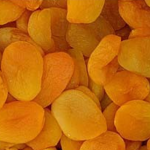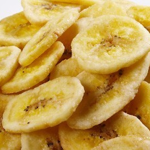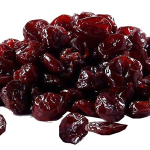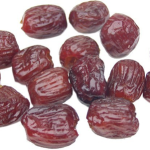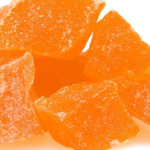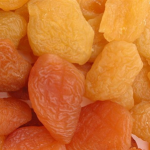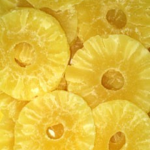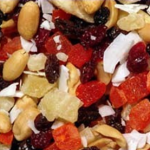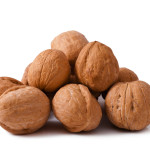ASIA LP markets a wide variety of delicious, healthful Premium Quality Dried and Glacé Fruits.
Chia Seeds
Salvia hispanica, commonly known as chia, is a species of flowering plant in the mint family, Lamiaceae, native to central and southern Mexico and Guatemala.[1] The 16th-century Codex Mendoza provides evidence that it was cultivated by the Aztec in pre-Columbian times; economic historians have suggested it was as important as maize as a food crop.[2] It is still used today with the seeds ground or whole seeds for highly nutritious drinks and food source.[3][4]
According to the USDA, a one ounce (28 gram) serving of chia seeds contains 9 grams of fat, 5 milligrams of sodium, 11 grams of dietary fiber, 4 grams of protein, 18% of the recommended daily intake of calcium, 27% phosphorus and 30% manganese.[7] These nutrient values are similar to other edible seeds, such as flax or sesame.[9][10]
In 2009, the European Union approved chia seeds as food.
Chia seeds may be added to other foods as a topping or put into smoothies, breakfast cereals, energy bars, yogurt, made into a gelatin-like substance, or consumed raw.[12][13]
Studies have found that 10 weeks ingestion of 25 grams per day of milled chia seeds, compared to intact seeds, produced higher blood levels of alpha-linolenic acid and eicosapentaenoic acid, an omega-3 long-chain fatty acid considered good for the heart, while decreasing inflammation and disease risk factors.[15][16]
http://en.wikipedia.org/wiki/Salvia_hispanica
Pine Nuts
Origin: China, Spain, Portugal, Pakistan
Pack Size: 55 lbs., 12.5 kg.
Varieties: Grade A
Peanuts
The peanut is a native to the Western Hemisphere, originating in South America and expanding throughout the New World as Spanish explorers discovered the peanut’s versatility. Later, traders were responsible for spreading the peanut to Asia and Africa. The peanut made its way to North America on sailing ships in the 1700′s.
Expansion, development, harvesting, shelling, and processing techniques played a major role in the peanut industry at the end of the 19th century. Peanut products – peanut oil, roasted and salted peanuts, peanut butter, and confections – were in demand by the 20th century. Today there are more than 300 uses for peanuts from recipes to institutional, baking, industrial, and confectionery products.
Peanut Portfolio
•Shelled or raw in-shell peanuts
•Blanched processed peanuts
•Organic peanuts
U.S. peanuts fall into four basic types:
•Runner
•Virginia
•Spanish
•Valencia
In-shell peanuts are usually produced from large Virginia or Valencia type peanuts. Commodity available in:
•Salted in the shell
•Roasted in the shell
Walnuts
Walnuts, the oldest tree food known to man are believed to have come from ancient Persia and were traded between Asia, the Middle East, and far off lands, making the Walnut one of the most popular nuts in the world.
While grown in many countries around the world, California, with its mild climate and deep fertile soils, provides ideal growing conditions for the English walnut, produces 99% of the total U.S. crop and 2/3 of the world’s trade. The walnut is a versatile ingredient nut. In manufactured food products, walnuts positively impact product flavor, texture, mouth feel, nutritional value, and stability. Walnuts are extremely functional in a wide variety of food processes: freezing, baking, broiling and roasting.
Walnuts are sorted into 8 sizes. Walnuts are sized over round hole screens expressed in 1/64î. These sizes range from 12/64î to 52/64.
Shelled Walnuts Packaging Options
As a general rule, pieces and halves are available in 25 lb. corrugated boxes with or without poly-lined bags. Smaller kernel sizes are usually available in 30 lb. boxes. Suppliers also ship in 1,000 to 2,000 lb. containers, #10 tins, and other industrial sizes.
Sizing | |
|---|---|
| Walnut Halves | 7/8 or more of the kernel is intact. 85% or more of lot, by weight, are half kernels with the remainder three-fourths half kernels. |
| Walnut Pieces and Halves | 20% or more of lot, by weight, are half kernels (7/8 or more of the kernel is intact). |
| Walnut Pieces | Portions of kernels in lot cannot pass through 24/64 inch round opening. |
| Walnut Medium Pieces | Although not covered in USDA Standards, Medium Pieces are a common size classification used in the California walnut industry. No less than 98% may pass through a 32/64-inch screen. |
| Walnut Small Pieces | Portions of kernels in lot pass through 24/64 inch round openings but cannot pass through a 8/64 inch round opening. |
| Walnut Meal | The smallest form of the walnut comes in various consistencies ranging from a coarse meal to a fine powder. Use walnut meal to dust cakes, use in dough and batter, and for walnut compounds. Finely ground walnut are incorporated into pastas, added to fillings and used as a thickening agent in sauces. |
| Topping Pieces | Portions of lot pass through 20/64 inch round opening. |
| Syrupers | Portions of lot pass through 28/64 inch round opening. |
GRADING | |
|---|---|
| Extra Light | No more than 15% shall be darker than extra light. |
| Light | No more than 15% shall be darker than light. |
| Light Amber | No more than 15% shall be darker than light amber. |
| Amber | No more than 10% shall be darker than amber. |
In-shell Walnuts – From the orchard to your table
According to USDA standards “inshell walnuts” are processed in several sizes:
- Jumbo
Large
Medium
* In-shell walnuts are packaged in 50 lb.
Storage
Walnuts should be stored in low moisture (55 – 65% relative humidity) and low temperature (32° – 28° F or 0° – 3.3° C) conditions. Keep walnuts away from excessive heat, moisture, light, and odors to ensure maximum shelf life and freshness
Pistachios
One of the oldest flowering nuts to be eaten by kings, queens, travelers and common folks was the “Pistachio,” “the power punch nut” was imported to the United States in the 1880’s.
While Turkey and Iran are the largest producers of pistachios, U.S. pistachios are predominately grown in California. This climate is ideal for the growth of consistent quality nuts. Pistachios are primarily used in snack mixes or as snacks themselves. Other uses for pistachios include ingredients for bakery goods and ice creams. Pistachios offer good nutrition as well as good taste. As with all nuts, Pistachios are a good source of the daily vitamins, minerals, and nutrients your body needs. One ounce of pistachios contains 3.1 grams of fiber-more than many recognizable high fiber sources such as raisins, potatoes, wheat bread, and celery. Also, because pistachios are a vegetable product, they are cholesterol – free.
Pistachios are sorted into 4 grades. These grades measure quality in terms of stain tolerance, foreign material and damage to the nutmeat. Stain tolerance is the level of discoloration that noticeably contrasts with the predominate color of the shell.
Sizing | |
|---|---|
| IN-SHELL PISTACHIOS | |
| Colossal | The pistachio size in which the average number of whole nuts per ounce is less than 18. |
| Extra Large | Average yield is 20 or less. |
| Large | Average yield is 20 or less. |
| Medium | Average yield is between 26-30 whole nuts per ounce. |
| Small | Average yield is 31 or more whole nuts per ounce. |
| PISTACHIO NUTMEATS | |
| 80% Whole Kernels | Eighty percent or more by weight shall be whole kernels. |
| 40% Whole and Broken Kernels | Forty percent or more by weight shall be whole kernels. |
| Large Pieces | Portions of kernels of which not more than 10% will remain on a 24/64 inch round opening. Not more than 25% of the total sample shall be whole kernels. |
| Small Pieces | Portions of kernels of which not more than 10% will remain on a 16/64 inch round opening. Not more than 3% of the total sample shall be whole kernels |
GRADING |
|---|
| IN-SHELL PISTACHIO GRADES |
| U.S. Fancy |
| U.S. Extra No. 1 |
| U.S. No. 1 |
| U.S. Select |
| U.S. Artificially Opened |
| U.S. Non-split |
| WHOLE KERNEL GRADES |
| U.S. Fancy |
| U.S. Extra No.1 |
| U.S. No. 1 |
PACKAGED IN | PALLET WEIGHT | 1 x 40 Foot Container | 1 x 20 Foot Container |
|---|---|---|---|
| 25 lb. Cartons | 80 cartons per pallet 2,000 lbs. net weight | 1,680 cartons | 1,140 cartons |
| 50 lb. Bags | 40 bags per pallet 2,000 lbs. net weight | 880 bags | 600 bags |
| 2,000 lb. Tote Bags | 1 bag per pallet 2,000 lbs. net weight | 22 bags | 10 or 12 bags |
| **25 pound bulk cartons—Roasted and Salted/Unsalted Inshell, or Raw Kernels | |||
| **50 pound bulk poly bags—Raw Inshell | |||
| **50 pound bulk poly bags—Raw Inshell | |||
Macadamias
Macadamias have a wide array of applications including delicately roasted and lightly salted snacks, delicious chocolate chip and macadamia cookies and ingredients for fine ice creams from around the world. Macadamias are grown in Australia, Hawaii, Costa Rica, Guatemala, and several regions of South Africa. The unique flavor and delicate texture of macadamias is a perfect ingredient to enhance any food product and elevate your product to a premium grade status.
Macadamias can be enjoyed in many different ways. From a lightly toasted snack nut to an exciting ingredient in confectionary and bakery products, macadamias can be tailored to fit your individual needs. Macadamia nuts are available in 9 different sizes.
Sizing | |
|---|---|
| Style 0 | Contains no less than 95% large whole kernels. This style is perfect for gourmet snack packs or for hand made confectionery. Sizes range upwards of 22mm. |
| Style 1 | Contains at least 90% whole kernels. This style is a specialty product for snack packs and chocolate coating. Sizes are at least 17mm. |
| Style 2 | Contains at least 50% whole kernels. This style is the most versatile product suitable for snack packs, confectionery and bakery products. Sizes range upwards of 13mm. |
| Style 3 | Contains at least 15% whole kernels and at least 90% half and larger kernels. This product is ideal for small snack packs. Sizes range upwards of 15mm. |
| Style 4 | Contains at least 80% half kernels and no more than 5% wholes. This size is excellent for use as an ingredient in bakery products, confectionery and small snack packs. Sizes range upwards of 9mm. |
| Style 5 | Consists of an industrial roasted product suitable for ice cream, cookies, fine food preparation and confectionery. Sizes range 9mm to 12mm. |
| Style 6 | This style is suitable for confectionery, ice cream, baking, topping and as an ingredient in other food preparations. Sizes are at least 5mm. |
| Style 7 | This size is only available in roasted form for use as a topping in breakfast cereals and in fine food preparations. Sizes range from 3mm to 6mm. |
| Style 8 | This size is excellent for soups and butter. Sizes are smaller than 3mm. |
Hazel Nuts
Hazelnuts are grown in many countries in the world today, and by all reports, is one of the world’s most plentiful nuts. The name hazelnut can be interchanged with the name filbert depending on geographical location.
While Turkey is the largest producer of hazelnuts in the world, the bulk of the hazelnuts consumed in the United States are domestically grown. Hazelnuts grow wild in many parts of the United States, but are grown commercially in Oregon and Washington. The hazelnut is used as an enhancement ingredient in many high quality confectionery and bakery products, as well as ice creams and salted snack mixes.
Hazelnuts are sorted into 6 sizes. The number of kernels per ounce determines hazelnut sizes. Hazelnuts are sorted into 2 grades. The two grades of hazelnuts are Oregon No. 1 and Oregon Whole and Broken.
SIZING | |
|---|---|
| Giant | The largest sized hazelnut. This size yields 15 or less per ounce. |
| Jumbo | Yields between 16-19 kernels per ounce. |
| X-Large | Yields between 20-24 kernels per ounce. |
| Large | Yields between 25-29 kernels per ounce. |
| Medium | Yields between 30-40 kernels per ounce. |
GRADING | |
|---|---|
| Oregon No. 1 | Consists of whole kernels meeting the following requirements: |
| a. Well dried and clean | |
| b. Free from foreign material, mold, rancidity, decay and insect injury | |
| c. Free from damage caused by chafing or scraping, shriveling, internal flesh discoloration | |
| d. Free from serious damage caused by serious shriveling and broken kernels. | |
| Oregon No. 1 Whole and Broken | Consists of whole kernels meeting the following requirements: |
| a. Well dried and clean | |
| b. Free from foreign material, mold, rancidity, decay and insect injury | |
| c. Free from serious damage caused by shriveling |
Pack Size: 55 lbs, 110 lbs
Varieties:
Turkey – #1′s, #2′s, Blanched or Natural
Oregon – Giant, Jumbo, XL, L, M, Whole, and Broken
Barcelona (In – shell) – Jumbo, XL, and Large
Cashews
Cashews are truly an international nut, grown on three continents and in both northern and southern hemispheres. Native to Brazil, the cashew was introduced to India and East Africa in the 16th century. Today the principal producing countries of cashews are still the countries in which they originated – Brazil, India, Vietnam and East Africa.
Cashews are primarily marketed roasted & salted for use in snacks and nut mixes. Raw cashews are marketed as an ingredient in many food products, particularly baked goods and are considered a “luxury” product in terms of nuts. With this reputation as a prestigious product, cashews are used as ingredients in many delicacies and chocolates.
The cashew kernels are obtained by cleaning, shelling, drying, peeling, grading, and packing the raw nuts. Kernels must have characteristic shape and be reasonably dry. Insect damage, black spots, and rancidity should not be evident on kernels.
Cashew kernels are sorted into white/scorched wholes, pieces, splits, butts etc. depending on the shape, size and color of the kernel. Cashews are sized by the number of kernels per pound. While different processors have distinct names for their cashews, the cashews are stilled sized based on the number of kernels per pound. These sizes range from 180 to 450.
Cashews are classified according to origin, i.e. Indian, Brazilian, African and Vietnamese, etc.
Sizing | |
|---|---|
| WHOLES | |
| 180 | The "king of cashews". They are largest sized cashew available. |
| 210 | Commonly known as "Jumbo" cashews. They are slightly smaller than the 180s. |
| 240 | The third largest cashew size available. This size yields 240 kernels per pound. |
| 320 | The most popular among cashew kernels and highest in terms of availability, worldwide. |
| 450 | The smallest and least expensive of whole kernels. |
| BROKEN | Butts, splits and pieces are priced lower than wholes and are ideal for cooking, and great as ingredients for delicacies and savory snacks. |
| White Pieces | B (Butts) S (Splits) LWP (Large White Pieces) SWP (Small White Pieces) BB (Baby Bits) |
| Scorched Pieces | SS (Scorched Splits) SP (Scorched Pieces) SB (Scorched Butts) SSP (Scorched Small Pieces) |
| Dessert Pieces | SPS (Scorched Pieces Seconds) DP (Dessert Pieces) |
GRADING | |
|---|---|
| LIGHT | White, pale ivory or light ash in color. |
| SCORCHED | Scorched kernels are another grade of cashew kernels, which have a slight brown color due to longer roasting. Scorched kernels have all the other characteristics of white kernels and have the same nutritional values. |
Brazil Nuts
Brazil nuts are the largest of the commonly consumed nuts. Everything about these nuts is big: from the tree on which it grows, to the huge fruit in which this nut appears. The massive tree that produces this nut can reach a height of 150 feet while the fruits in which the nuts are encased resemble large coconuts with a woody shell. Peru, Bolivia, Colombia, Venezuela and the Guianas, as well as Brazil, are home to Brazil nuts. Unlike domesticated nuts, Brazil nuts grow wild.
Brazil nuts can be enjoyed raw and roasted, salted or unsalted. They are popular in chocolates, ice creams, bakery dishes, confectionery items and snack mixes. Nutritionally, Brazil nuts contain significant nutrients, including protein, fiber, selenium, magnesium, phosphorus and thiamin. They are also rich in niacin, vitamin E, vitamin B6, calcium, iron and copper.
Brazil nuts are sized by number of kernels per pound.
SIZING | |
|---|---|
| KERNELS | |
| Large (or Giants) | 80 to 110 kernels per pound |
| Mediums | 110 to 130 kernels per pound |
| Smalls | 140 to 160 kernels per pound |
| Midgets | 160 to 180 kernels per pound |
| Tiny | 180 to 220 kernels per pound |
